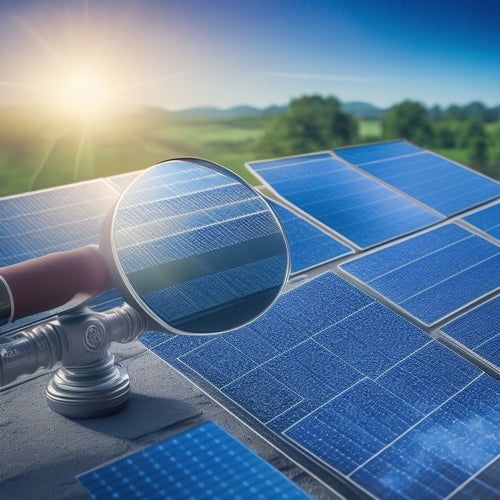
What You Need to Know About Solar Energy Panels for Your Home
Share
When considering solar energy panels for your home, you'll want to know that they can reduce your reliance on fossil fuels, lower your carbon footprint, and provide energy independence while shielding you from rising utility costs and power outages. You'll need to understand how solar panels work, the different types available, and the upfront costs, which can range from $15,000 to $30,000, depending on the system size and quality. Fortunately, federal tax credits, state and local incentives, and financing options can help offset the initial investment. Now that you've got a solid foundation, you can investigate further to determine if solar energy is right for you and your home.
Key Takeaways
- Solar energy panels reduce reliance on fossil fuels, lower carbon footprint, and provide energy independence, reducing energy bills and promoting sustainability.
- Understanding the different types of solar panels, including monocrystalline, polycrystalline, and thin film, helps homeowners choose the best option for their needs.
- Federal and state incentives, such as tax credits and rebates, can significantly offset the upfront costs of installing solar energy panels for homes.
- Professional installation and regular maintenance are crucial for optimal performance and longevity of solar panels, ensuring maximum energy generation.
- Assessing energy needs and evaluating roof space, including orientation, shading, and structural integrity, helps determine the suitability of solar energy panels for a home.
Benefits of Solar Energy
By utilizing the power of sunlight, solar energy panels can greatly reduce your reliance on fossil fuels, slashing your carbon footprint and contributing to a cleaner environment.
This significant reduction in environmental impact not only benefits the planet but also contributes to a sense of community responsibility. As you shift to solar energy, you'll be joining a growing movement of individuals committed to mitigating climate change.
In addition to the environmental benefits, solar energy panels can provide you with energy independence. By capturing the sun's energy, you'll be less reliant on the grid, reducing your energy bills and shielding yourself from rising utility costs.
This independence also means you'll be less affected by power outages, ensuring your home remains comfortable and functional during unexpected events.
With solar energy, you'll be taking a proactive step towards a more sustainable future, while also enjoying the financial and practical benefits that come with it.
How Solar Panels Work
One hundred sixty-five square centimeters of photovoltaic cells, typically arranged in a grid-like pattern, make up a standard solar panel. These photovoltaic cells are the heart of solar panel technology, converting sunlight into electrical energy. When sunlight hits the photovoltaic cells, it excites the electrons, causing them to flow through the material and create an electrical current.
Here's how it works in more detail:
-
Light absorption: Photovoltaic cells are made of semiconducting materials that absorb sunlight, exciting the electrons and generating an electrical current.
-
Electron flow: The excited electrons flow through the material, creating an electrical current that can be utilized and used to power your home.
-
DC to AC conversion: The electrical current generated by the solar panel is direct current (DC), which is then converted to alternating current (AC) through an inverter, making it usable in your home.
Types of Solar Panels
You've learned how solar panels convert sunlight into electrical energy, but did you know there are different types of solar panels to assess for your home? The most common types are monocrystalline and polycrystalline panels, which differ in their silicon crystal structure.
Monocrystalline panels have a higher solar panel efficiency, typically above 20%, while polycrystalline panels have a slightly lower efficiency, around 15-18%. Thin film technology is another option, offering a more affordable and flexible solution. Building-integrated photovoltaic (BIPV) solutions allow you to integrate solar panels into your roof or building design.
When choosing a solar panel type, consider factors like solar panel lifespan, installation methods, and environmental impact. Different solar panel brands offer varying warranties and performance guarantees.
As you examine your options, think about your energy needs, budget, and personal preferences. Future innovations, such as bifacial panels and perovskite cells, are also worth keeping an eye on.
Cost and Incentives
You're likely wondering what it'll cost to install solar energy panels on your home and what incentives are available to offset those costs.
The upfront system costs will vary depending on factors like the size of your system and the quality of the equipment.
Fortunately, federal tax credits and state incentives can help reduce the financial burden and make solar energy a more affordable option for you.
Upfront System Costs
The upfront cost of a solar energy system can be substantial, ranging from $15,000 to $30,000 or more, depending on the system's size, quality, and installation complexity.
While this may seem intimidating, it's crucial to evaluate the long-term benefits and available financing options that can make solar energy a more accessible choice for your home.
You'll want to weigh the upfront costs against the potential long-term savings on your energy bills. Here are some key considerations:
-
Financing options: Many solar panel installers offer financing plans or partnerships with lenders to help spread the upfront cost over time.
-
System efficiency: Investing in a high-quality system with a higher upfront cost may lead to greater long-term energy savings and a faster return on investment.
-
Local incentives: Check if your local government or utility company offers rebates, grants, or other incentives that can help offset the upfront cost of a solar energy system.
Federal Tax Credits
As you weigh the upfront costs of a solar energy system, it's important to factor in the benefits of federal tax credits, which can greatly reduce your out-of-pocket expenses. The federal government offers tax credits to homeowners who install solar energy systems, making it more affordable to go green. To be eligible for these credits, you must meet specific tax eligibility requirements set by federal regulations.
Here is a breakdown of the federal tax credits available:
| Year | Credit Amount | Phase Down |
|---|---|---|
| 2022 | 26% of total cost | No |
| 2023 | 22% of total cost | Yes |
| 2024 | 10% of total cost | Yes |
| 2025 and later | 0% | Yes |
| Systems installed prior to 2022 | 26% of total cost | No |
Keep in mind that these tax credits apply to the total cost of your solar energy system, including equipment and installation. By taking advantage of these credits, you can considerably reduce the cost of switching to solar energy. Be sure to consult with a tax professional to verify you meet all the necessary requirements.
State Incentives Available
Your state government may also offer incentives to help offset the cost of a solar energy system. These state programs can provide significant financial assistance, making it more affordable for you to invest in solar energy.
Some states offer rebates, tax credits, or property tax exemptions to homeowners who install solar energy systems. These incentives can vary widely depending on where you live, so it's important to research the specific programs available in your state.
-
Check if your state has a renewable portfolio standard (RPS), which may require utilities to purchase a certain amount of solar energy, driving up demand and creating incentives for homeowners.
-
Look for state-based tax credits, which can provide a credit against your state income tax liability.
-
See if your state offers property tax exemptions or reductions for solar energy systems, which can help reduce your property tax bill.
Installation and Maintenance
Solar panels require a thorough installation process to confirm peak performance and longevity. You'll want to ascertain that your solar panel installation is done correctly to maximize energy production and extend the lifespan of your system. A professional installer will assess your roof's size, orientation, and condition to determine the best placement of your panels.
Routine maintenance is essential to guarantee your solar panels continue to operate at their best. Here's a breakdown of what you can expect:
| Task | Frequency |
|---|---|
| Inspect panels for debris and cleaning | Quarterly |
| Check electrical connections and wiring | Annually |
| Verify inverter functionality | Semiannually |
| Monitor system performance | Monthly |
| Perform repairs and replacements | As needed |
Energy Efficiency Ratings
In conjunction with proper installation and maintenance, understanding energy efficiency ratings is essential to optimizing your solar panel system's performance. You want to guarantee that your system is generating the maximum amount of energy possible, and that's where energy efficiency ratings come in.
These ratings provide a standardized way to measure a solar panel's energy performance, giving you a clear understanding of how well it will perform in different conditions.
When evaluating energy efficiency ratings, look for the following key factors:
-
Efficiency percentage: This measures the percentage of sunlight that's converted into electrical energy. A higher percentage means more energy is being generated.
-
Temperature coefficient: This indicates how well the panel performs in high temperatures. A lower coefficient means the panel will maintain its energy performance even in hot conditions.
-
Durability and warranty: A longer warranty and more durable construction guarantee your panels will maintain their energy performance over time.
Is Solar Right for You
You're considering solar energy panels for your home, but before you invest, you need to determine if solar is right for you.
To start, you'll want to assess your energy needs to guarantee solar can meet your power requirements.
Next, you'll need to check local incentives and evaluate your roof space to verify it's suitable for solar panels.
Assess Your Energy Needs
Energizing your home with solar power begins with an essential step: evaluating your energy requirements. To determine if solar energy is right for you, you need to assess your energy consumption and power requirements. This involves understanding your daily energy usage patterns, including the time of day you use the most energy and the total amount of energy you consume.
-
Identify your energy-intensive appliances and devices, such as refrigerators, air conditioners, and electric water heaters, and consider their individual energy consumption.
-
Review your past electricity bills to determine your average daily energy usage in kilowatt-hours (kWh).
-
Consider your energy usage patterns, such as whether you use more energy during the day or at night, and whether you have any specific energy requirements, such as powering an electric vehicle.
Check Local Incentives Now
Having assessed your energy needs, your next step is to investigate the incentives that can make solar energy a more attractive option for your home.
You'll want to research local programs that offer financial assistance to homeowners who switch to solar power. These incentives can greatly reduce the upfront cost of installing solar panels, making the shift more affordable and increasing your potential savings.
Check with your local government to see if they offer any rebates, tax credits, or low-interest loans for solar energy installations.
You may also be eligible for federal incentives, such as the Solar Investment Tax Credit (ITC), which allows you to claim a portion of the installation cost as a tax credit.
Additionally, look into utility company programs that offer net metering, which allows you to sell excess energy back to the grid and offset your energy bills.
Evaluate Your Roof Space
Most homes have some degree of roof space available, but not all roofs are suitable for solar panels. To determine if your roof is a good fit, you'll need to evaluate its space and condition.
You'll want to take into account the following factors:
-
Roof orientation: Is your roof facing south, east, or west? These directions receive the most sunlight, making them ideal for solar panels.
-
Shading analysis: Are there any obstructions, such as trees or neighboring buildings, that could cast shade on your roof and reduce energy production?
-
Roof size and layout: Is your roof large enough to accommodate the number of solar panels you need to power your home, and are there any obstructions like vents, skylights, or chimneys that could interfere with installation?
If your roof checks out, you can move forward with evaluating your energy needs and exploring solar panel options.
Frequently Asked Questions
Can I Install Solar Panels on a Rented Property?
You'll need to check your rental agreements and understand your tenant rights before installing solar panels on a rented property, as some agreements may prohibit or have specific requirements for alterations to the property.
Do Solar Panels Work During Power Outages?
Ha! You're expecting solar panels to save the day during a power outage, but sadly, they won't - unless you have a battery storage system. Then, your solar panel functionality becomes a reliable power outage solution, keeping you lit while others are left in the dark.
Will Solar Panels Affect My Roof's Warranty?
You'll want to contemplate roof warranty implications when installing solar panels; ensuring your installer follows manufacturer guidelines and obtaining written confirmation of warranty maintenance will help you avoid potential issues and preserve your roof's warranty.
Are Solar Panels Resistant to Hail and Extreme Weather?
You'll be relieved to know that solar panels are built to withstand harsh weather conditions, including hail damage, and are designed with weather durability in mind, ensuring they'll continue to generate power even in extreme weather events.
Can I Sell Excess Energy Back to the Grid?
You generate, you conserve, and now you can capitalize: through net metering policies, you can sell excess energy back to the grid, earning credits via energy credit programs, offsetting your utility bills, and joining a community of sustainable homeowners.
Conclusion
As you consider utilizing the power of the sun, remember that solar energy panels are like an amplified savings account, generating clean energy and paying dividends for years to come. By now, you've got a solid grasp on the benefits, how they work, and what to expect. With the right system, you'll be soaking up the sun's rays like a sponge, reducing your carbon footprint and reaping the financial rewards. So, take the next step and shine a light on your path to energy independence.
Related Posts
-

Solar Panel System Certification Costs: A 10-Point Breakdown
You're looking to understand the costs associated with solar panel system certification. Your total certification cos...
-

Top 10 DIY Conversion Kit Reviews and Tips
You're taking the first step towards electrifying your ride, and with the right DIY conversion kit, you'll be cruisin...
-

What Are the Average Cost Savings of Solar Panels
You can expect to save between $400 and $1,000 per year on your electricity bills with solar panels, which translates...


